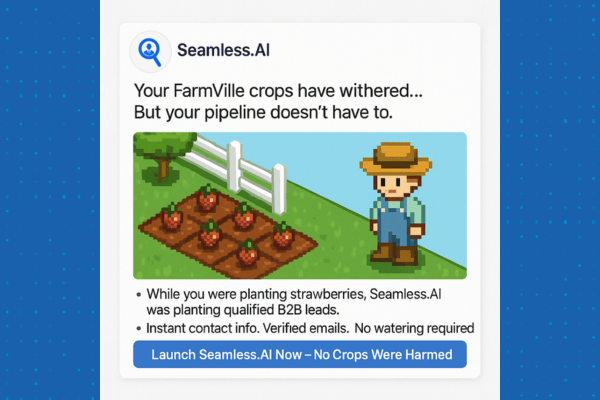- Practical Prospecting
- Posts
- 124: Why Burning Your TAM is a Myth
124: Why Burning Your TAM is a Myth
Step-by-step process to scrape, segment, and stay top of mind with every account in your TAM.
Welcome back to The Practical Prospecting Newsletter!
Today, we’re talking about how to scrape a list of every account in your total addressable market (TAM), then segment those accounts for high-volume, high-converting outbound campaigns.
Agenda:
Why burning your TAM is a myth
Building Your TAM the Right Way
Segmenting for High-Volume Outbound
Today’s newsletter is brought to you by Seamless.ai: The sales search engine with 1.3B+ decision-makers.
Why waste hours dialing dead ends when you can connect instantly with your ideal buyers?
Find & connect with decision-makers and power your workflows with our API so your CRM, marketing automation, and sales engagement tools work smarter for you.
Why “Burning Your TAM” Is a Myth
One of the most common questions I get from potential clients is:
“How do we know you won’t burn our TAM?”
It’s a fair question. We send high-volume cold emails, and first impressions matter. The fear is that if prospects don’t like our emails, they’ll never want to hear from us again, and we’ll lose email as a channel.
The problem with that thinking is it’s from your perspective, not your prospect’s.
Here’s the reality:
Roughly half of the emails you send will never even be seen. They get buried or deleted instantly.
Of the half that do get seen, 90% will be skimmed and deleted.
That means 95% of your emails are forgotten within seconds.
Think about it. How many cold emails have you received that you actually remember? Probably a handful at most.
Email is a marketing channel, and the first rule of marketing is to stay top of mind. As long as you send high-quality, relevant, personalized emails with value-driven offers, you won’t burn your TAM.
That’s why we only send 2–3 email sequences to a prospect before pausing, then retarget them with new messaging a month later.
We also mix up CTAs: not every email asks for a meeting. Sometimes the offer is a resource, audit, or video.
Burning your TAM happens when you send 6–8 sequences in 2–4 weeks, hammer people with the same message, and get blocked. That’s when you’re truly done.
A few more tips:
Rotate who on your team sends emails so prospects see different names and styles.
Change messaging angles between campaigns.
Aim for one touch point on every account in your TAM every 3 months.
Outbound is a game of timing. Stay relevant, and when the problem becomes urgent enough, they’ll think of you.
Building Your TAM the Right Way
It all starts with pulling your total addressable market.
Step 1 — Start with data, not guesses
Brainstorm with your team on who they think the best customers are.
Enrich your actual customer list with data like company size, industry, roles, and tech stack.
Compare what they say vs. what the data shows. The truth is usually somewhere in between.
Step 2 — Create a one-page ICP guide
Keep it simple and share it with stakeholders.
Here’s a free GPT we created to do it.
Make sure everyone’s aligned before you start building the list.
Step 3 — Find companies first, worry about contacts later
If you sell to white collar industries, use LinkedIn data via ZoomInfo, Clay, Seamless, Apollo, or Sales Navigator.
If you sell to blue-collar industries, you’ll need to scrape Google with tools like Serper or Apify, or find public databases.
For example, one of our clients targets private clinics. We used the NPI registry to pull every clinic in the US.
If you sell to e-commerce, use Storeleads.
Pro tip: Ask GPT “Where can I find a public database of [audience]?”
Step 4 — Target the right TAM size
Ideal: 10,000–50,000 accounts.
Over 50K → narrow with filters (industry, size, role, tech).
Under 10K → loosen criteria.
Too broad means low-quality replies. Too narrow means you’ll run out of accounts.
Segmenting for High-Volume Outbound
Once you’ve found companies, then pull contact data using the tools above. For blue collar targets, scrape websites with Claygent to find public emails since most email finders need a LinkedIn profile.
When segmenting, keep it simple. I used to go overboard: persona, industry, company size, tech stack, etc, and ended up with 20+ sequences. Quality always suffered.
Instead, focus on the single most important common denominator that will change your messaging. Usually, that’s just persona.
Signal-based lists are great, but remember they usually only cover 10–20% of your TAM (e.g., hiring, new leadership, product launches, funding). For those, set up automated campaigns to catch the signals. The rest of your list should get cold emails that focus on offers and lead magnets.
If you approach it this way, you can work your entire TAM consistently without burning it, and be the first one they think of when they’re ready to buy.
Thanks for reading,
Jed
